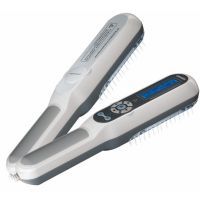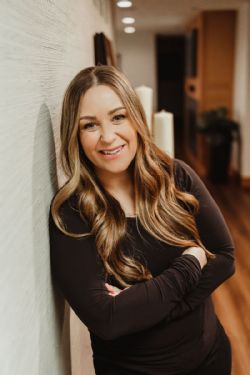 Written by Amanda Lundberg, BSN, RN
Written by Amanda Lundberg, BSN, RN
 | Brightwand for Narrow-Band UVB Light Therapy View Product |
Rosacea, eczema, and psoriasis are three common skin conditions that affect millions of Americans. Treatment options for these conditions vary, but they tend to weigh heavily on pharmaceuticals and surgery. For example, rosacea treatments are typically medicines or surgical procedures, and most eczema treatments consist of creams. If you are comfortable with pharmaceuticals and medical procedures, then this article is not for you. BUT, if you are searching for treatments that are non-pharmaceutical, non-invasive, and overall safe - keep reading!
While there is not a cure for these skin conditions, there ARE alternative treatments out there! Thankfully, recent clinical research has shown some promising results from the use of light therapy products to help manage these skin conditions, reduce associated inflammation and itchiness, and improve overall skin appearance.
Below, we break down exactly how light therapy treats these skin conditions, explain other conditions that light therapy treats, share testimonials from real people, and answer frequently asked questions.
Table of Contents |
Eczema is another skin condition showing promising results with light therapy intervention. There are generally three different types of phototherapy used for the treatment of eczema namely broadband UVB, narrowband UVB, and UVA. Although exact mechanisms are still unknown, the light emitted has a natural effect on the immune system contributing to reduced skin inflammation and associated itching and redness. By suppressing an overactive immune response, the body reduces the concurrent inflammatory response. This can reduce multiple eczema symptoms including redness, pimples, flaking skin, and follicular keratosis. Treatment frequency should be coordinated with your physician but typically involves several weeks of consistent sessions 2-3 days per week. Once improvements are seen, the frequency of treatment will gradually be reduced and results monitored.
Light therapy, also known as phototherapy, is a treatment used for a variety of health conditions that isolates specific wavelengths from the light spectrum. The light emitted triggers the body to respond by activating various reactions within the cells causing beneficial and therapeutic results.
Rosacea is one such skin condition that has shown promising results with light therapy intervention. Although the cause of rosacea is unknown, it results in excessive redness in the cheeks, nose, forehead, and chin. Light therapy has been shown to have many therapeutic effects including increased energy production, reduced inflammation, and increased hormesis. The wavelengths emitted in light therapy penetrate the skin and trigger the mitochondria to increase ATP, or energy levels, within the cells. This promotes more efficient oxygen consumption and activates the body’s natural defenses to decrease associated redness. Light therapy also acts to reduce inflammation by turning on specific organelles which increase collagen and stimulate healing. Finally, light therapy has been shown to activate a process called hormesis which causes short-term stress to a structure to promote subsequent strengthening. As it applies to rosacea, this can cause an increased defense mechanism against rosacea-triggering irritants.
Although additional research is needed to determine the long-term benefits of light therapy for rosacea, it is generally agreed that both red light LED therapy and red and blue light therapy can reduce visible blood vessels and associated redness even after a few treatments. Repeated treatment is often necessary to maintain skin improvements and reduce subsequent flare-ups.
Similar to both eczema and rosacea, light therapy for psoriasis works by reducing inflammation levels in the system and decreasing associated itching and pain. Exposure to UV light has also been shown to disrupt abnormal or faulty signals that occur in psoriasis between skin cells and immune cells causing lesions. By exposing the skin to light and reducing immune response, the body effectively can speed up the rate of healing and reduce the risk of chronic symptom development. Studies have shown promising benefits from both UVB light, UVA light, and red light therapies, giving users options in terms of treatment availability. Different types of phototherapy will require varying frequency and duration however most individuals are recommended to perform 2-3 sessions per week for a few weeks to see the greatest benefit.
In addition to the above-stated conditions, light therapy is now being used for several health conditions and cosmetic purposes. Advancements made in research and medicine have popularized the treatment and shown results for the following conditions:
“My 14-year-old son has suffered from eczema for years. We started light therapy a few months ago and it has healed his eczema better than any of the prescriptions or creams we have used over the past 6 years.”
-Maggie C.
“Light therapy is the help I have been hoping for for a long time. I have been using the therapy consistently for a month now and I can very clearly see improvement in my skin tone and overall redness. If you are suffering from rosacea, consider this treatment. After trying so many failed products, I’m happy I gave light therapy a chance.”
-Emily R.
“My rosacea has progressively gotten worse since I had three children, and it makes me extremely self-conscious. I just began using light therapy and I am already seeing a difference. I’ve spent so much money over the years on products that didn’t have any effect on my skin. Finally, something that helps- my family has noticed a change too!”
-Kristin W.
A: Depending on the wavelength of light emitted, goggles may or may not be required during light therapy. With a quality device that emits only red light, goggles are likely not required. Conversely, with any ultraviolet light exposure, it is important to shield your eyes as this wavelength can cause eye damage with excessive exposure. If you are unsure of the wavelength emitted, have light sensitivity, or are prone to light-induced headaches, eye protection is recommended.
A: For most skin conditions, ongoing treatments are often required to manage condition-associated symptoms. With regards to psoriasis, rosacea, and eczema, light therapy helps manage the symptoms but does not cure the condition itself therefore continued treatments may be required.
A: Phototherapy has minimal to no side effects when used appropriately and as directed. Mild redness may occur immediately after treatment but typically resolves within a few hours following light exposure.
Light therapy has shown great promise in the management of several skin-related conditions including rosacea, eczema, and psoriasis. Light therapy is valuable for many reasons - one being it’s a low-risk alternative to more invasive treatment options. When selecting an appropriate light therapy device, it is important that the user be aware of the wavelength of light emitted, the quality of the product, and recommended appropriate use. In a world with limited treatment options available for some skin conditions, light therapy provides hope and evidence-based research to improve skin conditions and help individuals regain the confidence they deserve to look and feel their best.
Didn't find what you were looking for? Browse all Light Therapy products or our entire catalog of Therapeutic Modalities products.
Interested in learning more? Check out our free, educational resource Caregiver University. You will find incredible articles about light therapy, hyperbaric oxygen therapy, cryotherapy, and much more!
Want to get social? Find dozens of videos featuring products and tips like these on Rehabmart’s YouTube channel! And follow the RehabMart.com Facebook!

Amanda is a registered nurse with over a decade of experience in hospital, clinic, and healthcare management settings. Her primary focus has been collaborating with patients to manage disease processes. Aiming at continuing active lifestyles for her patients, Amanda has become an expert in adjunct therapies.
Amanda incorporates a holistic approach to heal the body from within. She has completed extensive research in remedial treatments using oxygen, as well as becoming a professional light therapy specialist. Her reparative ethos to health has sparked engaging conversations and teaching opportunities nationwide.
Amanda has taken her passion for articulating technical medical language and transitioned to freelance writing. She enjoys bringing a clinical voice to health and wellness brands.